The Influence of Sports Classes on Quality of Life of Students of Tyumen State Agrarian University
Фотографии:
ˑ:
V.A. Kuvaldin
State agrarian university of the Northern Transurals, Tyumen
Key words: physical culture and sport in student environment, quality of life, athletes, various aspects of health, indicators of physical component of health, indicators of mental component of health.
Development of physical culture and sport in the student environment is an extremely relevant issue associated with preservation and promotion of health of future specialists [3].
Speaking of the role of sport when preparing for life and the future profession, it cannot be limited to the development and improvement of the body's various functions. Sports training, "via the method of inurement to actions and behavior", ensures acquisition of necessary qualities: self-discipline, perseverance, persistence in overcoming difficulties, confidence, determination and ability to exercise maximum efforts in sports, at work and in social activities [4, 1].
Physical culture extends adaptive capacities, and optimal physical loading promotes health, while excessive physical loadings, when doing sports, can have a negative effect on the organism [5, 6, 2].
As marked in numerous researches, injuries at sports classes affect health status and mental state [8, 7, 9 et al.]. One is to be especially careful with sports classes for students, since physical overloads along with heavy study loads can be irrecoverably damaging for a young body. It is rather hard to combine strenuous study loads and sports training process, especially in view of the top level of sports results and requirements of the future profession. Therefore, appropriate living conditions are created in the university for top athletes, so they can study according to an individual timetable.
Therefore, the studies of the effect of sports classes in spare time on the students' quality of life are especially interesting.
More than a third of the Tyumen State Agrarian University students train regularly, not only in special hours at the university, but also in their free time, as well as participate in competitions. In addition to this, the study of the influence sports occupations have on the students' free time, regarding their quality of life (QoL), is of special interest.
The purpose of the study was to make a comparative analysis of the indicators of physical and mental component of health of ordinary students and students involved in sports.
Materials and methods. We carried out a comparative analysis of the indicators of physical and mental components of health of ordinary students (178 boys and 265 girls) and students involved in sports (40 boys and 18 girls) of the Tyumen State Agrarian University. To evaluate the QoL, which is closely related to health, the russified version of the method SF-36 (Russian version created and recommended by MCQLR) was used, consisted of 36 items for the identification of the subjective assessment of the respondents' quality of life. The items, with the form of symbolisms, are divided in eight scales, characterizing the physical and mental components of health. The number of points in the evaluation of each scale ranges from 0 to 100. The greater the number of points, the higher the QoL is.
Results and discussion. The involved-in-sports students, against the backdrop of their high “physical functioning” (PF) of 94.5 ± 1.46 vs. 90.1 ± 1.39 points (p 0.05), showed a statistically significant reduction in the indicator of the scale "effect of physical state on the role performance” (RP) and a sharp reduction in bodily pain (BP), in comparison with the students not involved in sports; 52.5 ± 3.66 vs. 76.7 ± 1.39 points and 41.6 ± 1.21 vs. 79.5 ± 0.96 points respectively at p 0.001 (table 1).
Table 1. Indicators of physical component of health of ordinary students and students involved in sports
|
Indicators |
Boys |
р |
Girls |
р |
||
|
Ordinary students, |
Athletes, |
Ordinary students, |
Athletes, |
|||
|
n=178 |
n=40 |
n=265 |
n=18 |
|||
|
GH, points |
73.6±0.97* |
74.4±1.46 |
>0.05 |
67.7±0.69* |
73.4±2.72 |
<0.05 |
|
PF, points |
90.1±1.39 |
94.5±1.46 |
<0.05 |
88.26±0.77 |
96.1±0.65 |
<0.001 |
|
RP, points |
76.7±1.39 |
52.5±3.66** |
<0.001 |
75.19±0.77 |
72.2±6.48** |
>0.05 |
|
BP, points |
79.5±0.96 |
41.6±1.21** |
<0.001 |
78.75±0.69 |
64.6±4.47** |
<0.01 |
Note. Here and in table 2: the differences between male and female students were statistically significant (* – р<0.05; ** – р<0.01).
The female athletes' group, against the backdrop of their increasing PF to 96.1 ± 0.65 ± 88.26 vs. 0.77 points (p 0.001), also shows a reduction in PT, but to a lesser degree than that of the boys: 64.6 ± 4.47 vs. 78.75 ± 0.69 points (p 0.01). In addition to this, we don't have a reduction of the indicator of the RP scale in female athletes.
Table 2. Indicators of mental component of health of ordinary students and students involved in sports
|
Indicators |
Boys |
р |
Girls |
р |
||
|
Ordinary students, |
Athletes, |
Ordinary students, |
Athletes, |
|||
|
n=178 |
n=40 |
n=265 |
n=18 |
|||
|
MN, points |
69.74±1.2** |
72.6±1.90* |
>0.05 |
65.5±0.77** |
66.6±2.33* |
>0.05 |
|
RE, points |
64.6±1.39 |
63.3±3.66** |
>0.05 |
66.04±0.77 |
81.5±6.48** |
<0.05 |
|
SF, points |
80.7±1.22 |
75.0±2.75 |
>0.05 |
79.39±0.77 |
77.8±4.86 |
>0.05 |
|
VT, points |
67.0±1.1 |
71.5±1.83** |
<0.05 |
64.23±0.73 |
61.6±3.56** |
>0.05 |
The singularity of the mental component of health regarding students involved in sports (Table 2) lies in the higher "vitality" (VT) of 71.5 ± 1.83 vs. 67.0 ± 1.1 points to that of the students not involved in sports (p 0.05). Regarding the female athletes, an increase of the scale value "effect of emotional state on the role functioning" (RE) is observed, comparatively to female students not involved in sports, just as with the male students involved in sports: 81.5 ± 6.48 vs. 66.04 ± 0.77 and 63.3 ± 3.66 points (p 0.05 -0.01) respectively.
For determining the correlation between high and low scale indicators describing the various aspects of the respondents' health, an analysis was carried out with the use of the QoL gradation we acquired.
As you can see from the present chart (fig. 1), in 90% of cases the involved-in-sports students get high indicators of QoL, in terms of PF scale. But against this backdrop, in comparison with the students not involved in sports, low indicators of such physical state scales, such as RP and "bodily pain" (BP), occur markedly more often: 40 vs. 14.6% (p 0.01) and 35 vs. 2.8% (p 0.01) respectively. What's more about the same scales, high indicators (excellent QoL) are less likely to occur for athletes: 20 vs. 52.1% (p 0.01) and 0 vs. 37.6% (p 0.001) respectively.
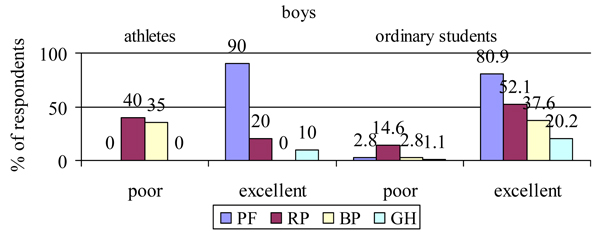
Fig. 1. The proportion of respondents with poor and excellent quality of life on the scale of physical condition (in % of respondents)
When examining the correlation between high and low values on the scales of mental state (Fig. 2), we come to the conclusion that there are no cases of students involved in sports with low values on the scale of "vitality" (VT) and "mental health assessment" (MH), while ordinary students show poor QoL on these scales, at 4.5 and 11.1% of cases (p 0.01) respectively.
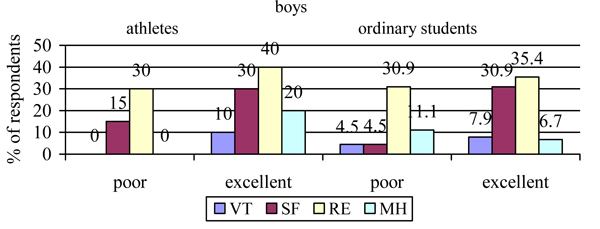
Fig. 2. The proportion of respondents with poor and excellent quality of life on the scale of mental condition (in % of respondents)
Moreover, the athletes show high values on the MH scale more often: 20 vs. 6.7% (p 0.05).
As we can see from the graph (fig. 3) the value of the PF scale is high in all the involved-in-sports students: 100 vs. 64.1% (p<0.001) in not-involved-in-sports students.
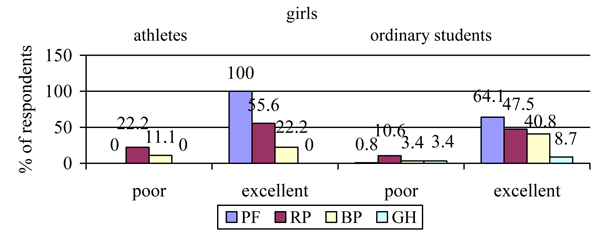
Fig. 3. The proportion of respondents with poor and excellent quality of life on the scale of physical component (in % of respondents)
When it comes to athletes, high indicators of the scale “general health state” (GH) are not observed: 0 vs. 8.7% (p<0.05) and a high value of the PB scale is almost two times less likely to occur: 22 vs. 40.8%, although the differences seemed statistically unreliable: tendency (p>0.05 with t=1.84).
Upon studying the correlation between high and low values on the scale of psychological state (fig. 4), it appears that, in the case of athletes, low values on the RE scale are less likely to occur: 11 vs. 31.7% (р<0.01), while on the MH scale low values were not observed at all: 0 vs. 38.5% (р<0.001), although on that scale we didn’t have high values: 0 vs. 12% (р<0.05).
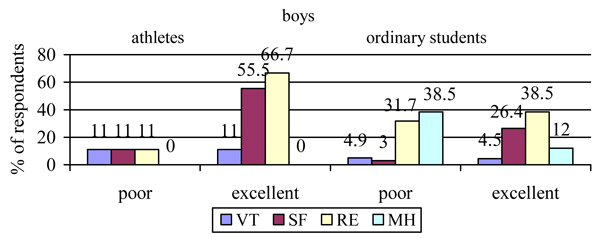
Fig. 4. The proportion of respondents with poor and excellent quality of life on the scale of psychological state (in % of respondents)
In the case of athletes, in comparison with students not involved in sports, they are more likely to have high values on the scales “social functioning” (SF) and RE; 55.5 vs. 26.4% (р<0.05) and 66.7 vs. 38.5% (р<0.05) respectively.
From the profile of the male and female students’ QoL, who combine their studies with sports activities (fig. 5), we reach the conclusion that there are significant differences between the QoL of the former and the latter students. Indeed, the QoL of female athletes on such indicators of physical health component, just as with RP and BP, suffered to a lesser extent than that of the male athletes with likewise high physical functioning (PF).
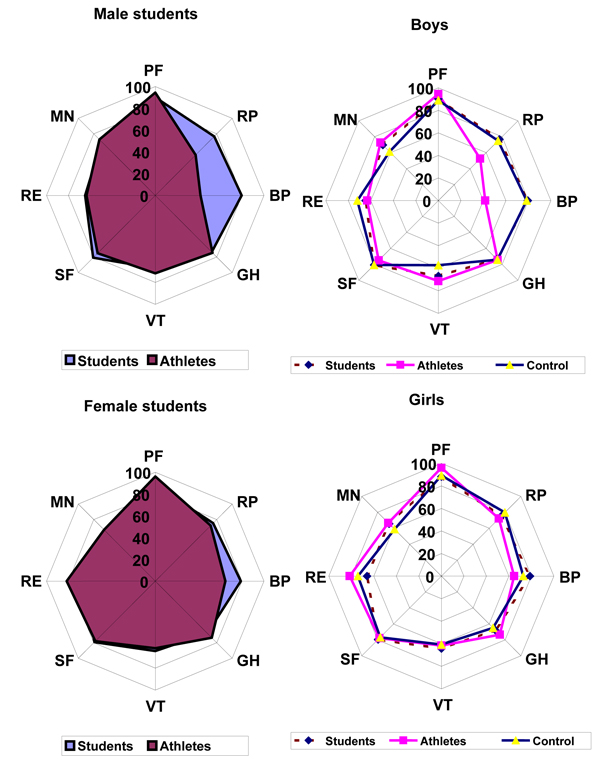
Fig. 5. Profiles of QoL
The differences in the profile of QoL between the out-of-school youth and the students involved in sports are even more expressed compared to those with the students not involved in sports, except that, in the group of female athletes, the reduction of the indicators in question related to girls, who don’t attend university and are not involved in sports, is not evident, with the sole exception of the ВР scale; a reduction of bodily pain is observed in the case of female athletes.
Conclusions. In reference to students involved in sports, against the backdrop of high “physical functioning”, a reduction of the indicator of the scale “effect of the physical state on the role performance” occurs as well as a drastic one of the bodily pain in not-involved-in-sports students respectively. Regarding the group of female students involved in sports, against the background of the increase of “physical functioning”, the reduction of bodily pain occurs to a lesser extent.
The singularities of the health’s psychological component in male students involved in sports have to do with higher “vitality”, while in female students involved in sports an increase in the value of the scale “effect of the emotional state on the role performance” is observed. Furthermore, in the case of male students involved in sports, 90% of them show high indicators of QoL on the scale of “physical functioning”, while in the respective female cases the percentage is 100%.
Moreover, low indicators on such scales of physical state as the “effect of the physical state on the role performance” and the “pain intensity” are significantly more likely to occur in students involved in sports. In proportion to the above-referred scales, high indicators occur less often with athletes. In the case of athletes not found with high indicators on the scale “general health state” and almost twice less likely, than students not involved in sports, high values of the scale “pain intensity” are observed.
Moreover, cases with low values on the scales “vitality” and “assessment of mental health” are not found in male students involved in sports. On the contrary, high values on the scale “assessment of mental health” occur more frequently in them. In the case of female athletes involved in sports, low values on the scale “effect of the emotional state on the role performance” are less likely to occur, while on the scale “assessment of mental health”, just as with male athletes, low values were not observed at all, although on that scale high values were not detected either. Moving on, in the case of female athletes, high values on the scales “social functioning” and “effect of the emotional state on the role performance” are more frequent than in female students not involved in sports. There are significant differences between the QoL of male and female athletes in terms of the profile of their QoL with their high value of physical functioning likewise.
Institute studies combined with sports classes increase the quality of life, especially in the group of girls. But the bodily pain decreases with severe increase of the level of physical performance. The quality of life of young female athletes is significantly higher regarding such indicators of the physical component of health as the effect of physical status on role performance and pain intensity, compared to male athletes.
References
- Il’inich, V.I. Student sport and life / V.I. Il’inich. – Moscow: Aspekt press, 1995. – 140 P. (In Russian)
- Isaev, A.P. The strategies of human adaptation: study guide / A.P. Isaev, S.G. Pichagina, T.V. Potapov. – Tyumen, 2003. – 248 P. (In Russian)
- Orinchuk, V.A., Orinchuk, A.N., Lapchinskaya, N.V., Bol’shev, A.S. Estimation of quality of life and the role of physical culture on formation of healthy way of life of first-year students / V.A. Orinchuk, A.N. Orinchuk, N.V. Lapchinskaya, A.S. Bol’shev // Proceedings of the IV internat. theor.-pract. conf. devoted to the 60th anniversary of the faculty of physical education and sport “Physical culture and sport of young students in the modern environment: problems and perspectives of development”. – Tula: publ. h-se of TulSU, 2008. – P. 155-157. (In Russian)
- Puni, A.Ts. Psychology physical education and sport/ A.Ts. Puni / Ed. by T.T. Dzhamgarov. – Moscow, 1979. – P. 82-90. (In Russian)
- Suzdal’nitsky, R.S. New approaches to interpretation of sports stress immunodeficiencies / R.S. Suzdal’nitsky, V.A. Levando // Teoriya i praktika fizicheskoy kultury. – 2003. – № 1. – P. 18-22. (In Russian)
- Taymazov, V.A. Sport and immunity / V.A, Taymazov, V.N. Tsygan, E.G. Mokeeva. – St.Petersburg, 2003. – 200 P. (In Russian)
- Coleman, P.G. Personality, health and ageing // J. Roy. Soc. Med. – 1997. – N 32. – P. 27-33.
- El-Naggar, A.M. Physical training effect on relationship of physical, mental, and emotional fitness in adult men // J. Hum. Ergol. – 1986. – Vol. 15, № 1. – P. 79-84.
- Jones, P.P. et al. Gender does not influence sympathetic neural reactivity to stress in healthy humans // Amer. J. Physiol. – 1997. – N 1, 2. – Р. 350-357.
Author’s contacts: tyumenkfk@yandex.ru



